a chance to compare and contrast
/Looking around the showrooms and studios that were open for 3daysofdesign - the event held in Copenhagen at the end of last month - it was easy see why the Danish furniture and design industry is so strong.
For a start, Denmark has a well-established and well-deserved reputation for designing and making some of the best furniture in the World. Presumably that means that companies here have loyal customers and a head start in attracting new customers.
And because there are so many manufacturers and designers in Copenhagen there does appear to be strength in numbers: attending various events last month it was obvious that although there is healthy rivalry there is also a very strong and a very positive feeling that there really is a design community in the city.
If young designers can say that they were trained in Denmark and work here then they have credibility … even if, actually, they themselves feel that the downside is having to compete in a crowded market place.
Looking at this concentration of design talent - going to the showrooms of top manufacturers and visiting high-end design stores and looking at so many companies over just a few days - you realise just how broad and how diverse the design industry in Denmark is … from small companies that were started recently by one or two enthusiastic and talented people through to large companies with a long-established reputation for the style and quality of their furniture. In some cases that reputation stretches back more than a century.
For companies to have a distinct style is, or at least should be, a major asset - that is having a defined brand image and a core market to aim at - to use the jargon - but this is probably one of the most difficult aspects of the design industry to get across to people outside the design industry so to the buying customer who is, after all, the ultimate target for all these amazing things.
Generally, customers will see new designs in a large design store where the style of the piece may well be difficult to appreciate in the melee, however well laid out the furniture in a store is, so there will be either oddly juxtaposed pieces from different companies or there may be some distance and possibly a gap of some time between searches in different stores. That is why catalogues or at least some sort of image in publicity material is still important despite this being the age of on-line images and mobile phones for taking your own pictures.
Anyway, compare and contrast exercises are not easy so I thought it might be interesting to look at three different design companies in Copenhagen - companies that were chosen because they are not small - not the one designer and a lot of drive and energy type company - but nor are they the large long-established design names.
I was able to spend a fair bit of time at the Gubi showroom at Nordhavn and at the Muuto studio and headquarters in the centre of the city and also at the showrooms and headquarters of &Tradition on Paper Island on the south side of the main harbour. *
What the three companies have in common is that the core work of all three is that they produce and sell both furniture and lighting. Design work is either in house, in the case of Muuto, or a mixture of in house and designs commissioned from independent designers and both Gubi and &Tradition also produce a number of older pieces - mid 20th-century classic designs under licence.
In terms of the style of their products and, I suspect, in their business plans and long-term aims, the three companies could not be more different.
Looking at their products in design stores or in adverts or magazines, the differences are more difficult to isolate - but visiting the showrooms, the differences are much more obvious.
Gubi

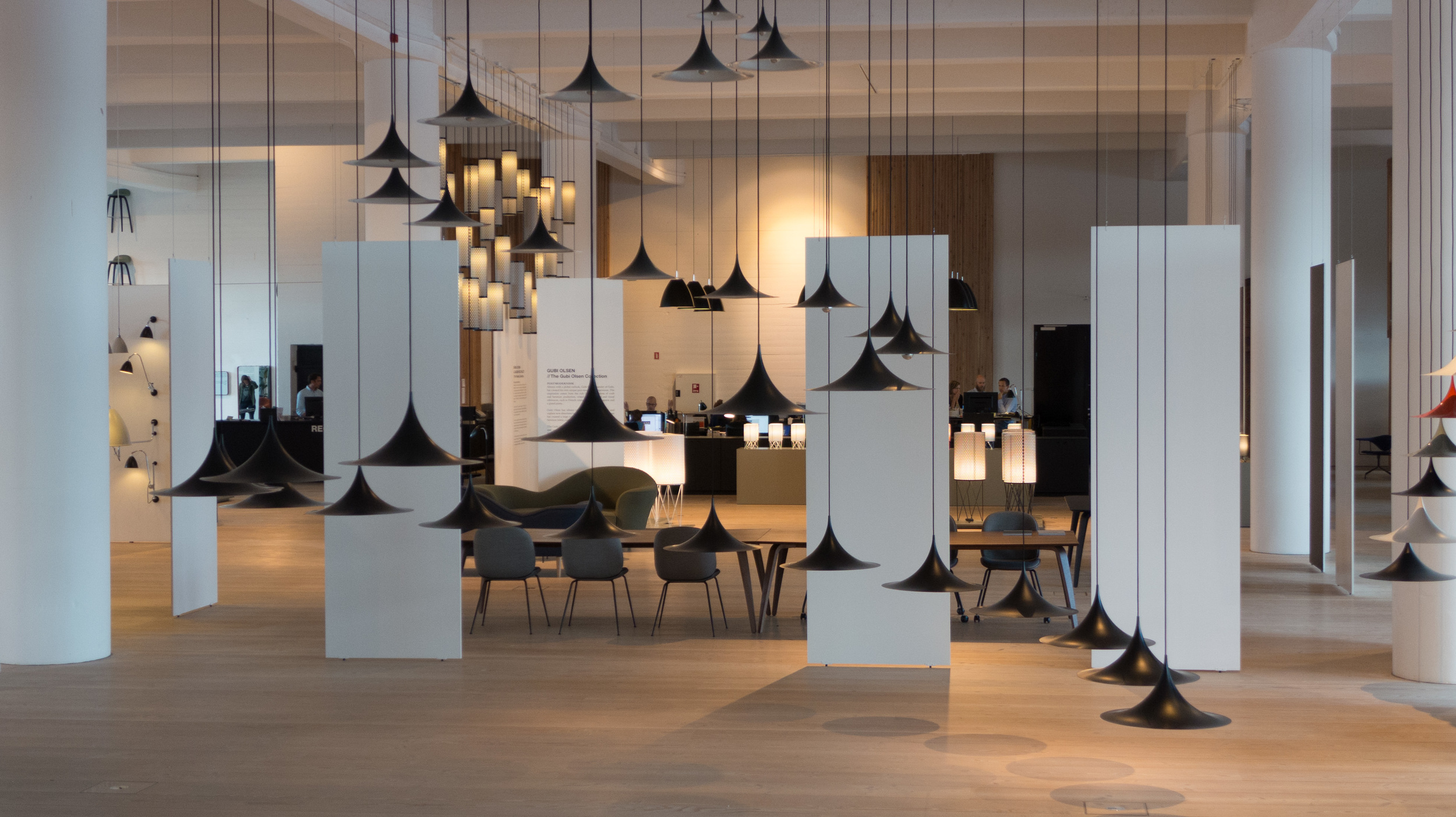
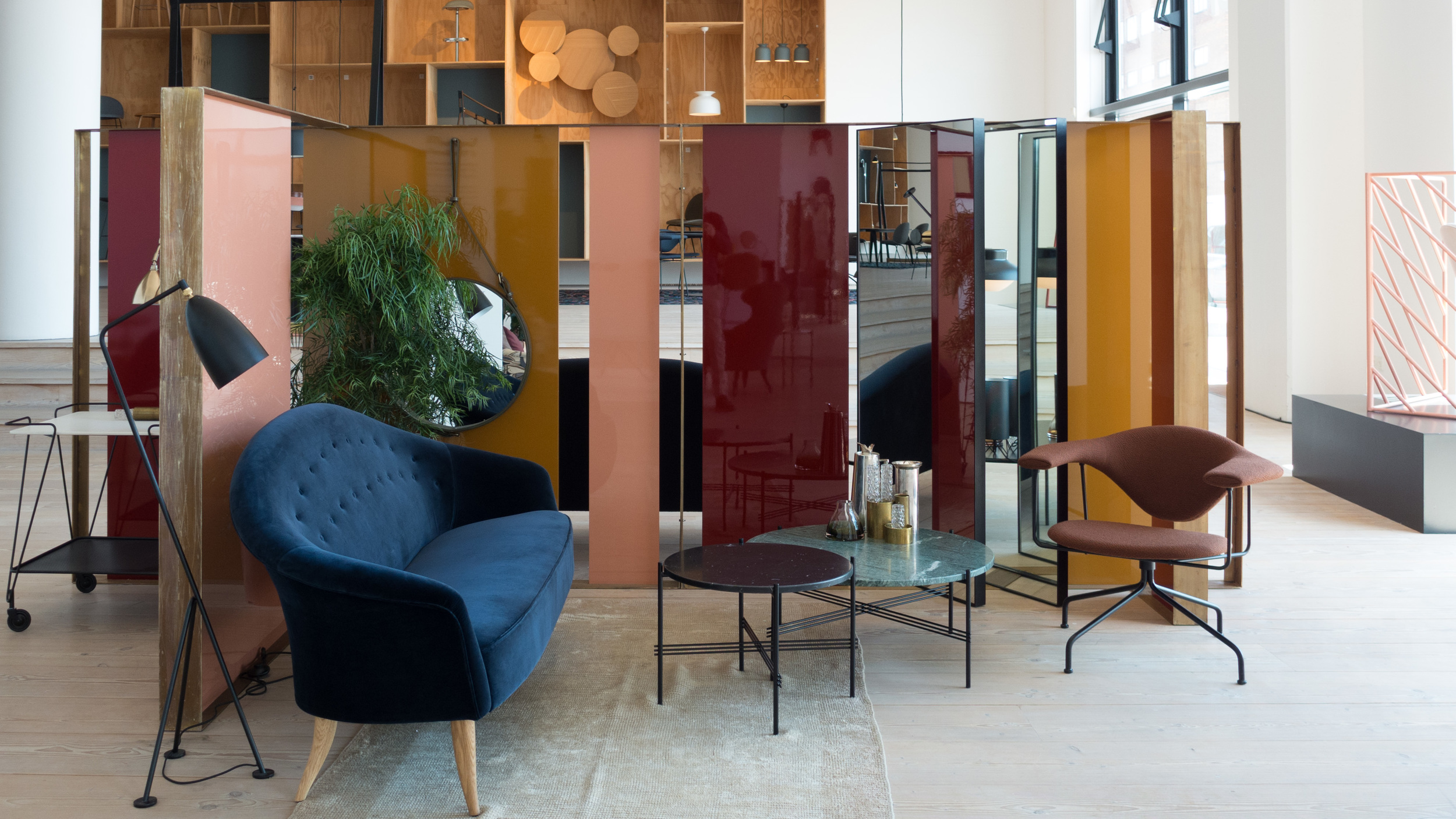
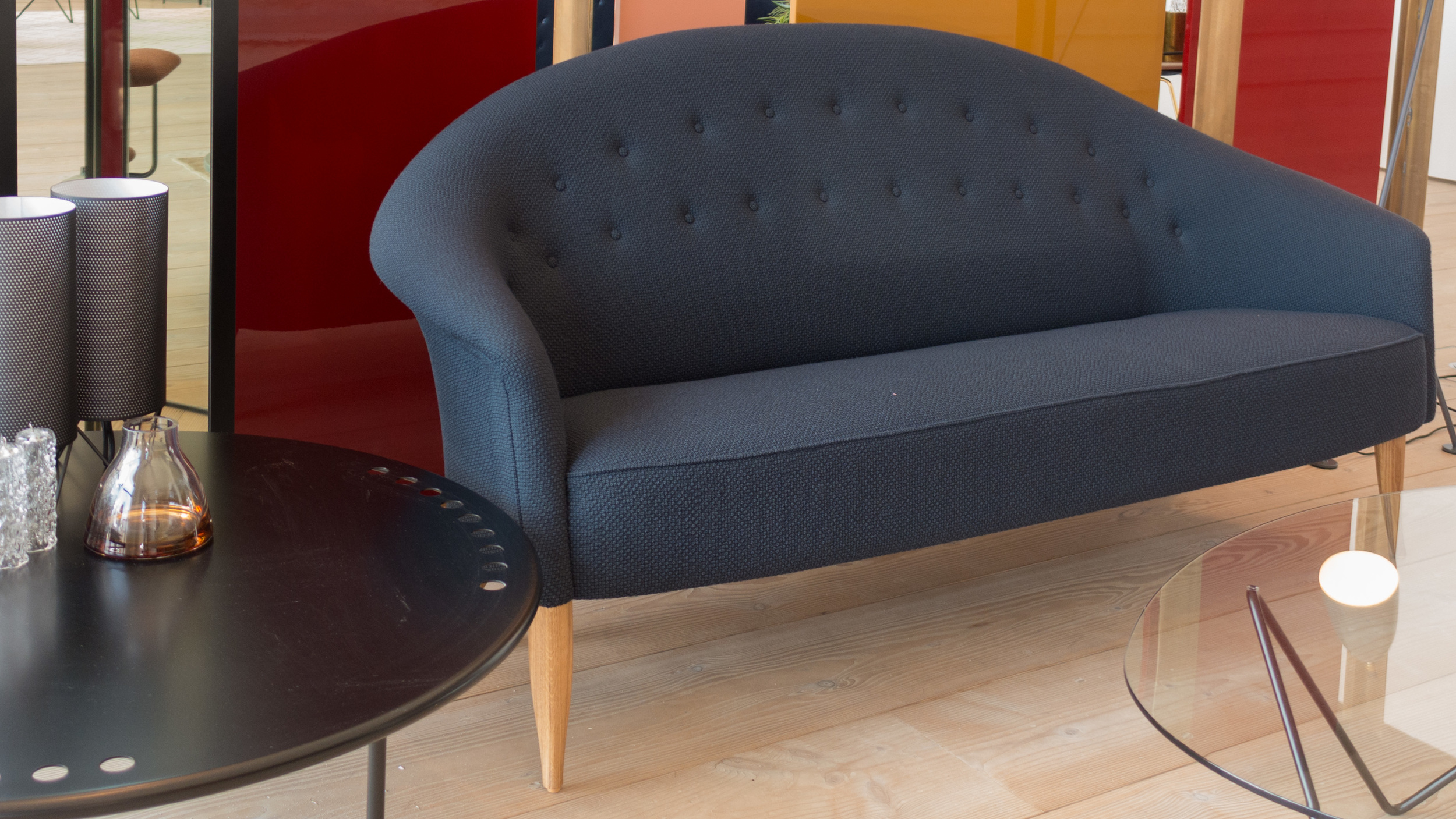
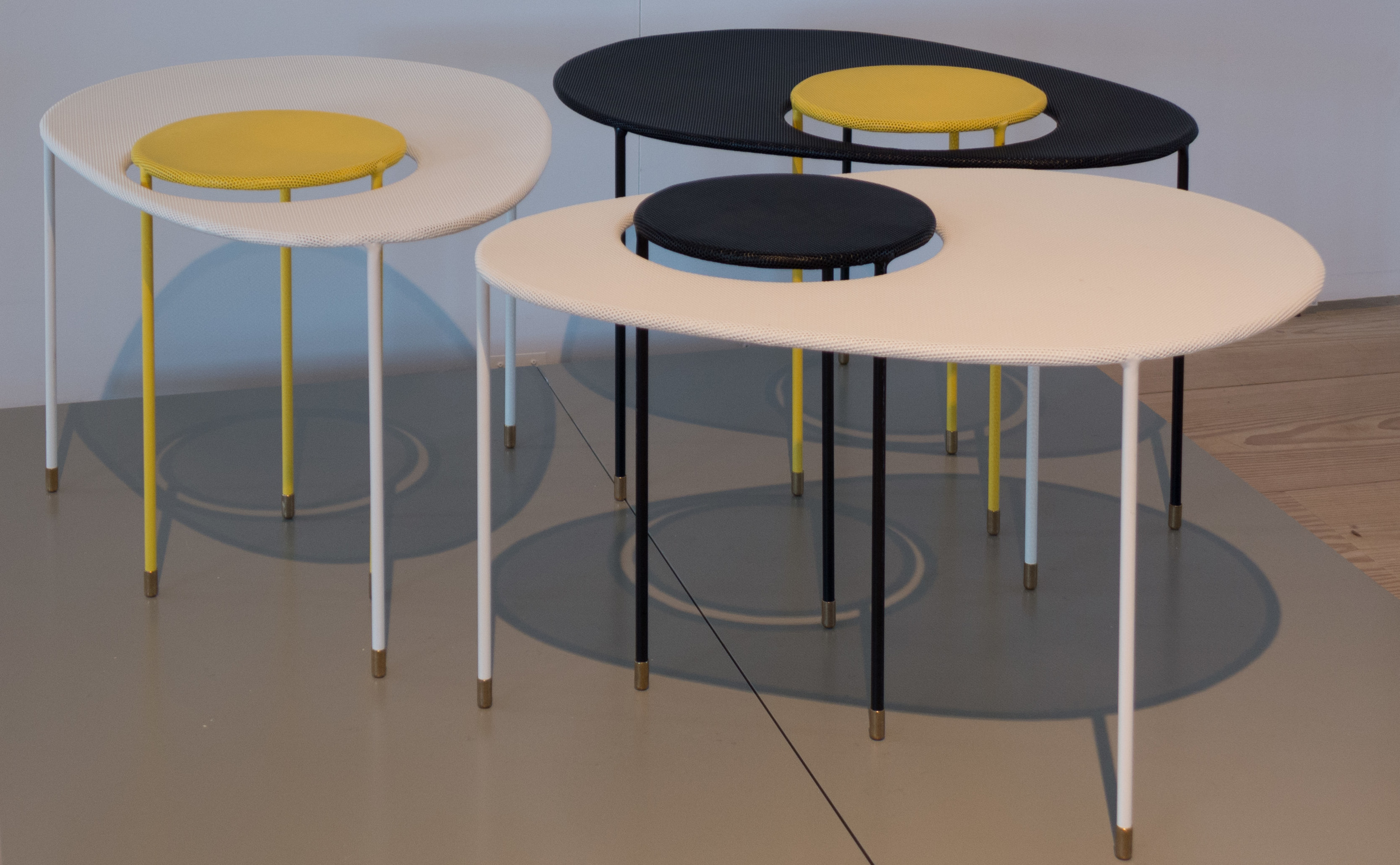
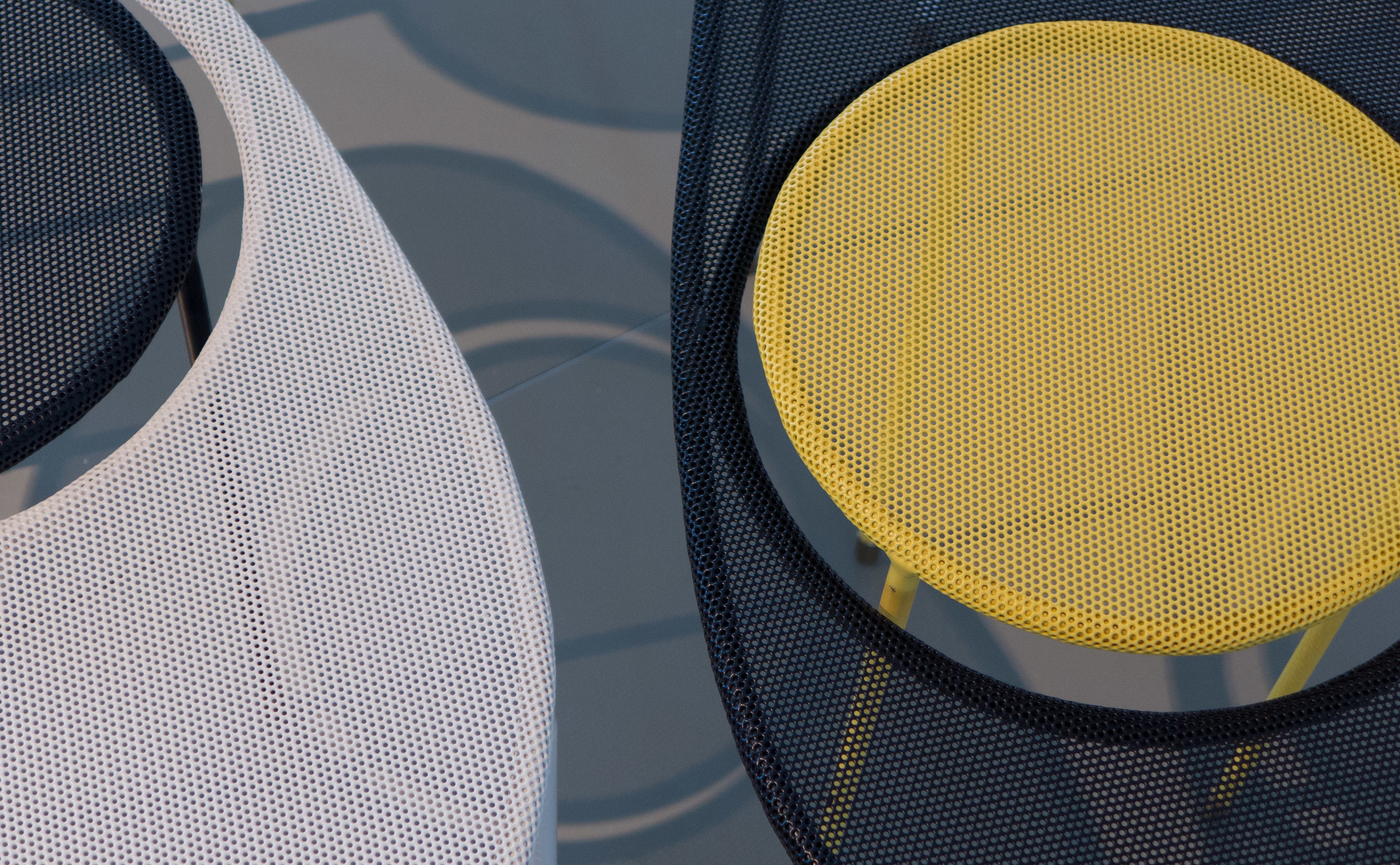
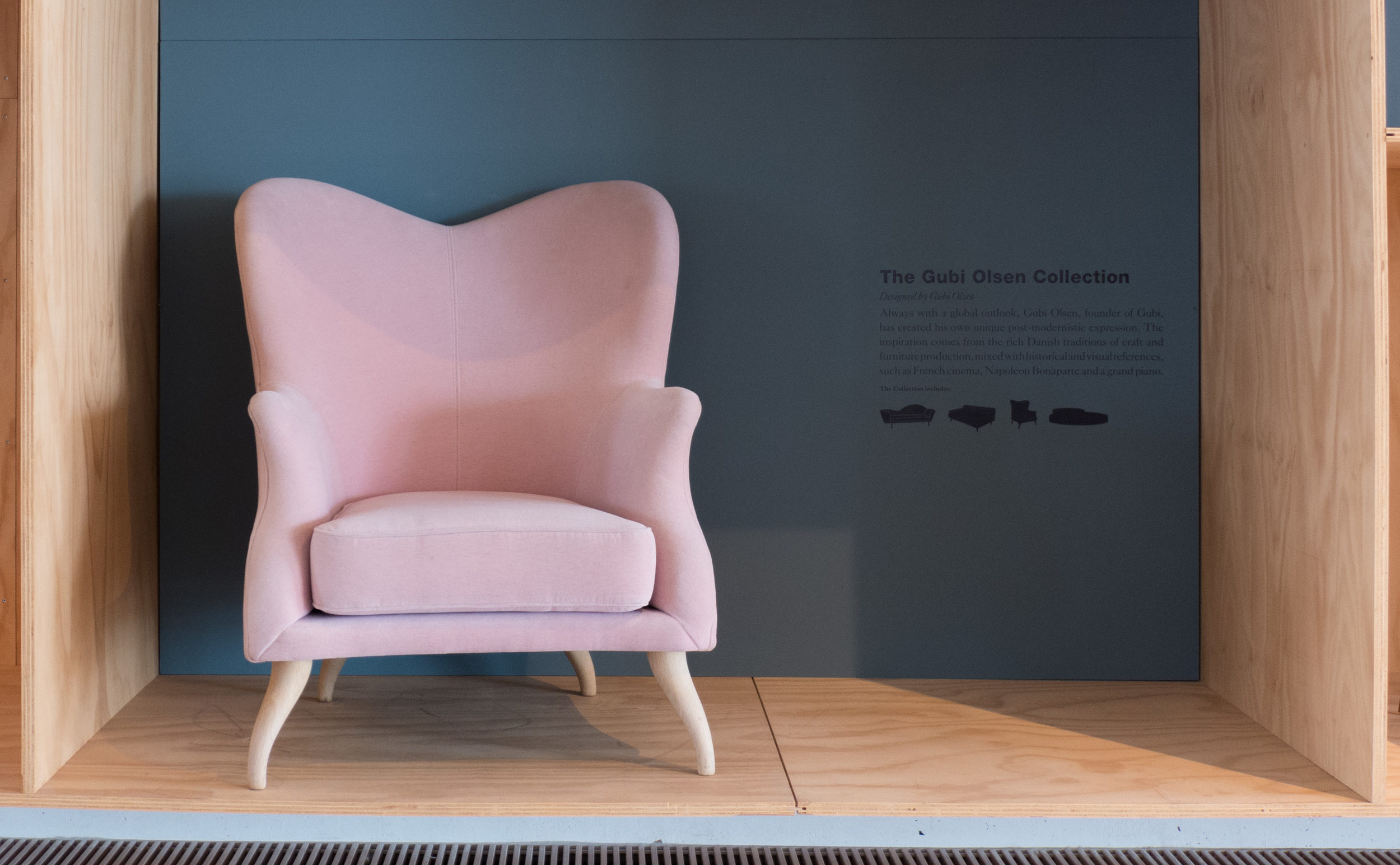

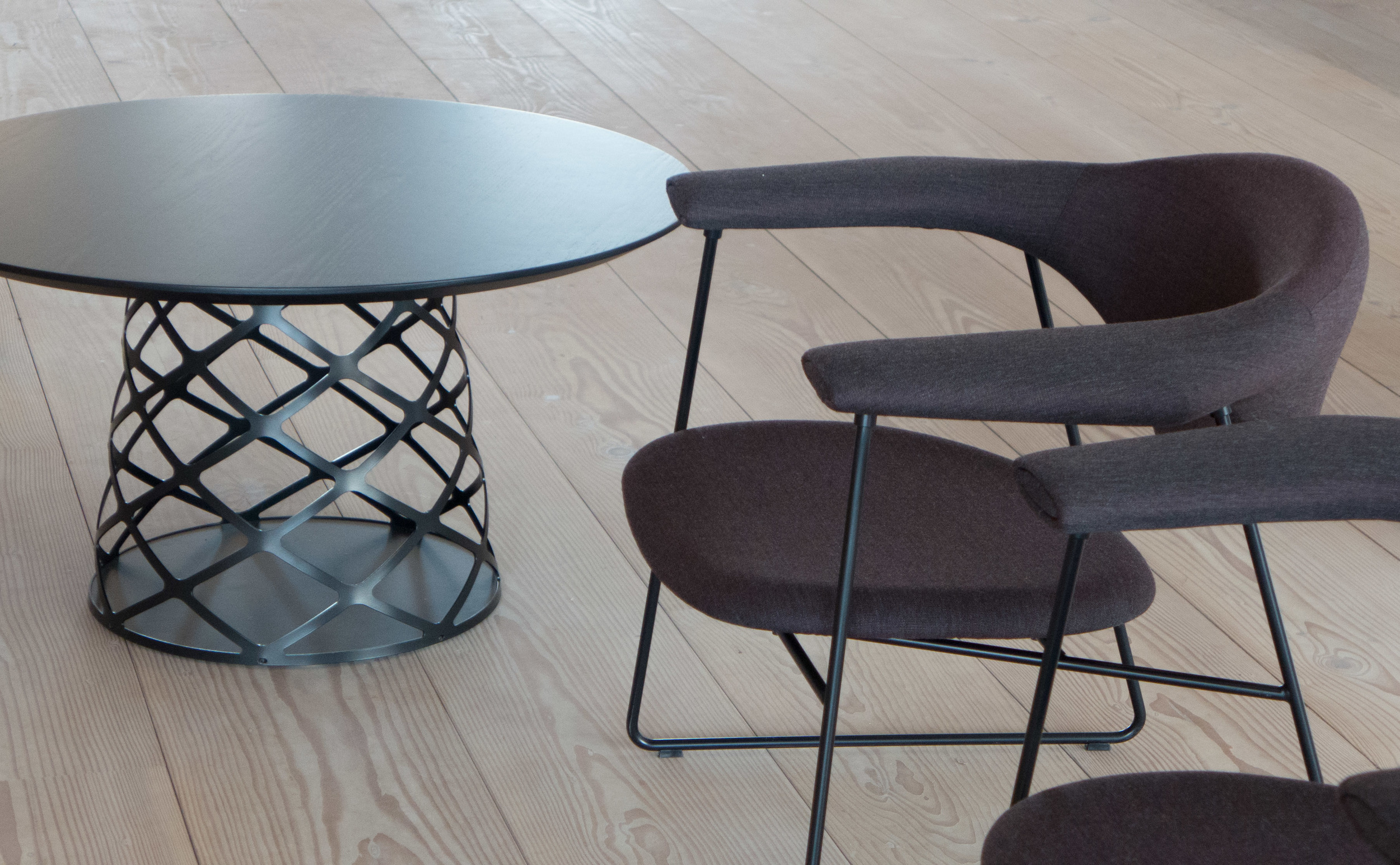
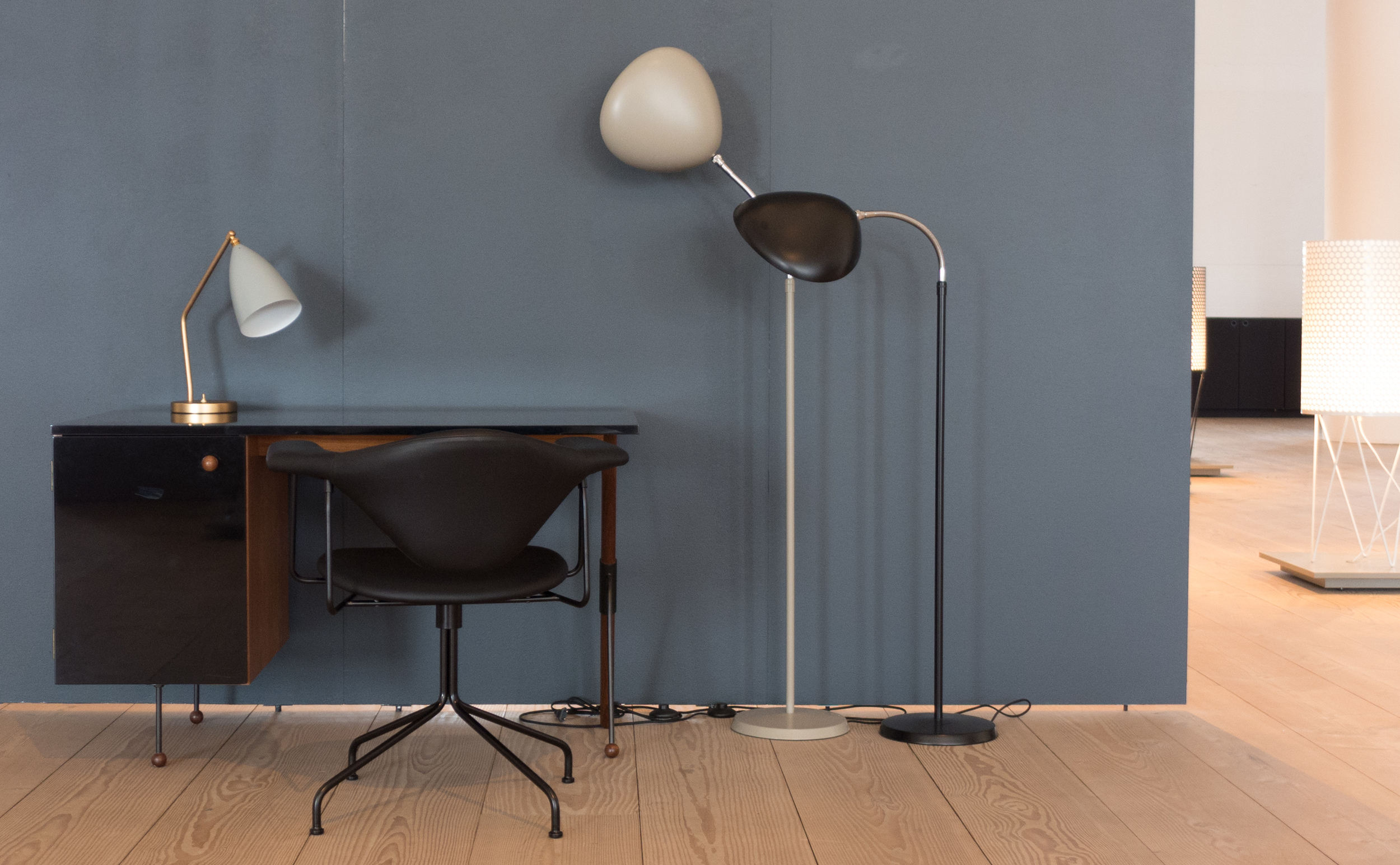
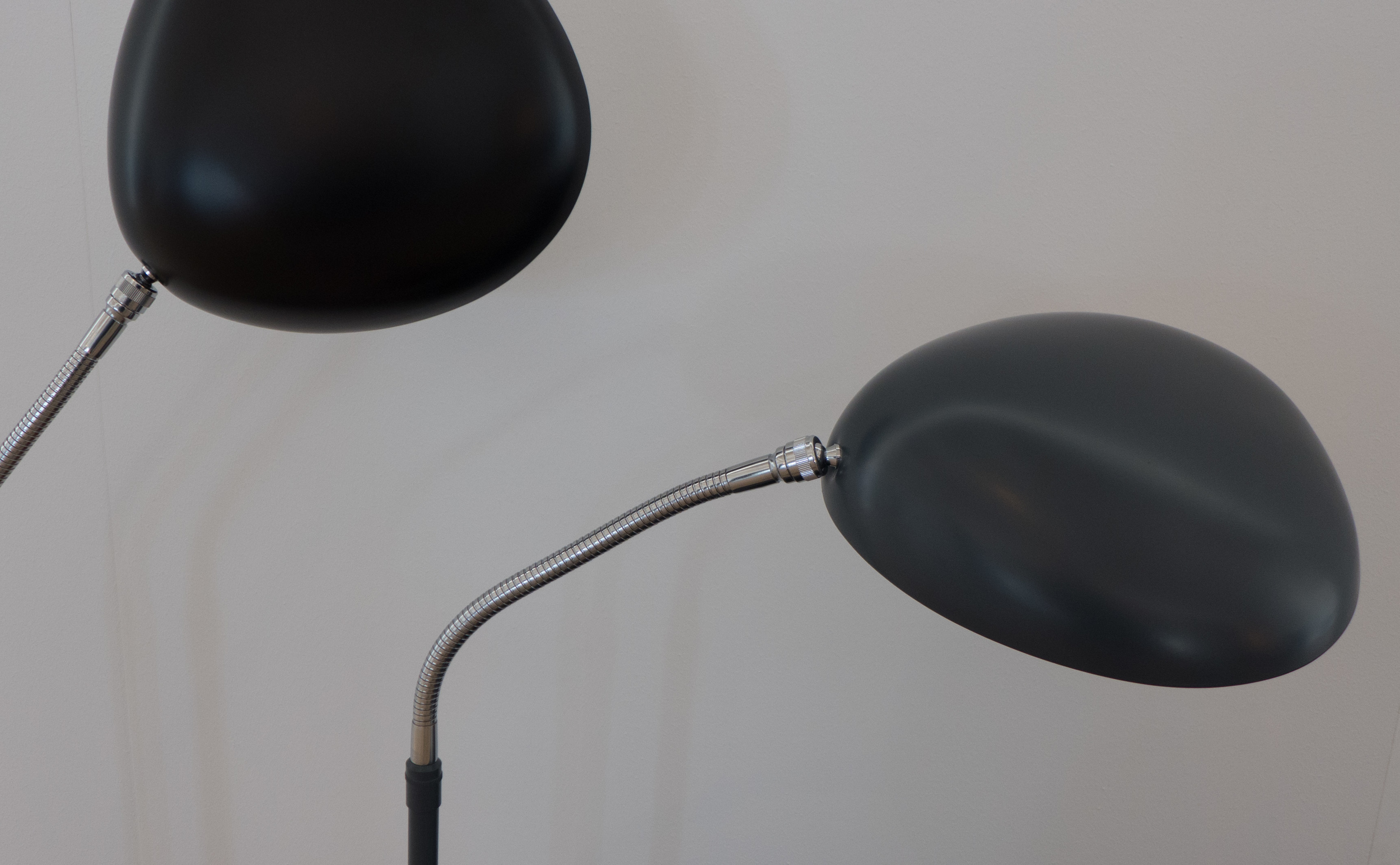
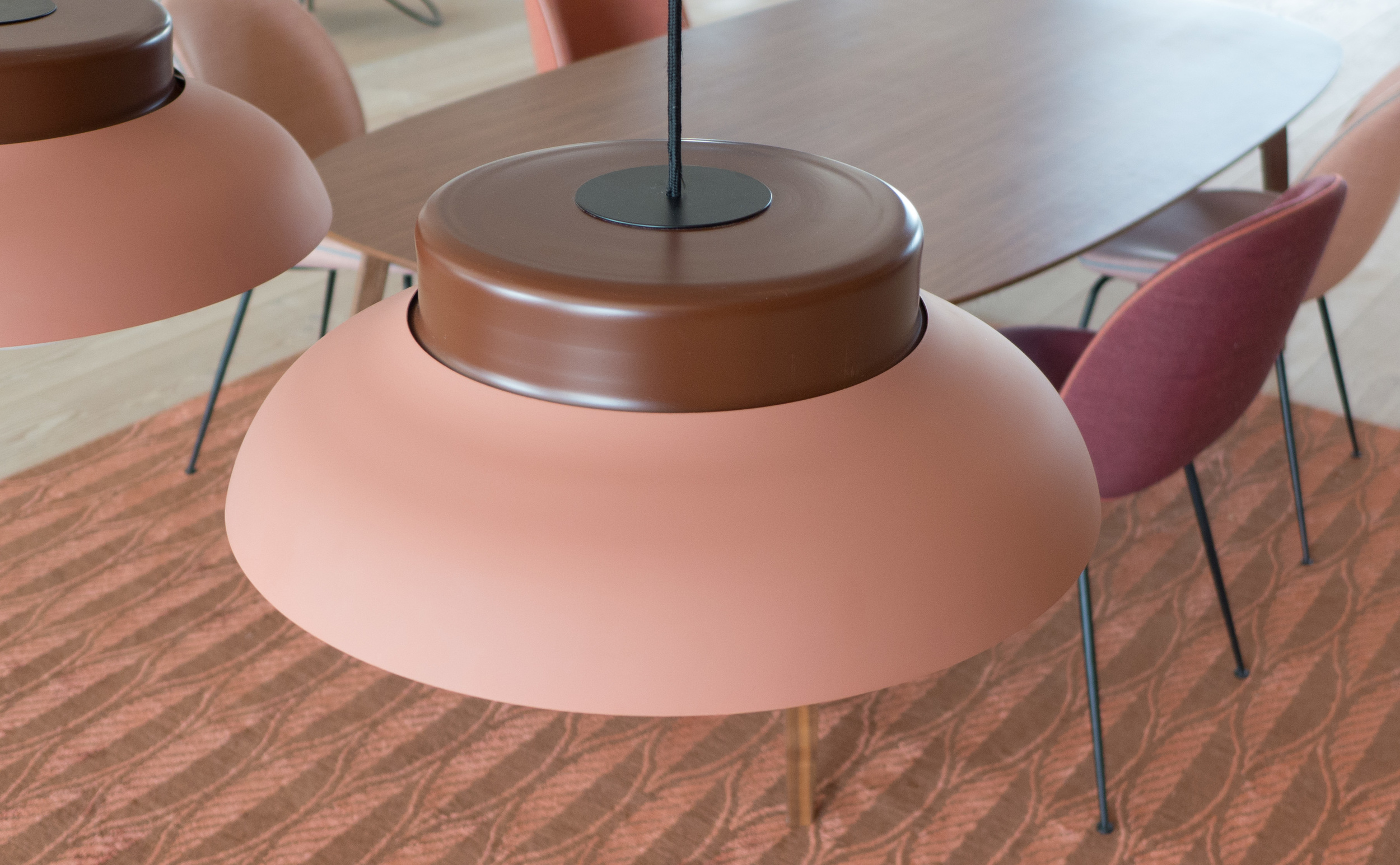
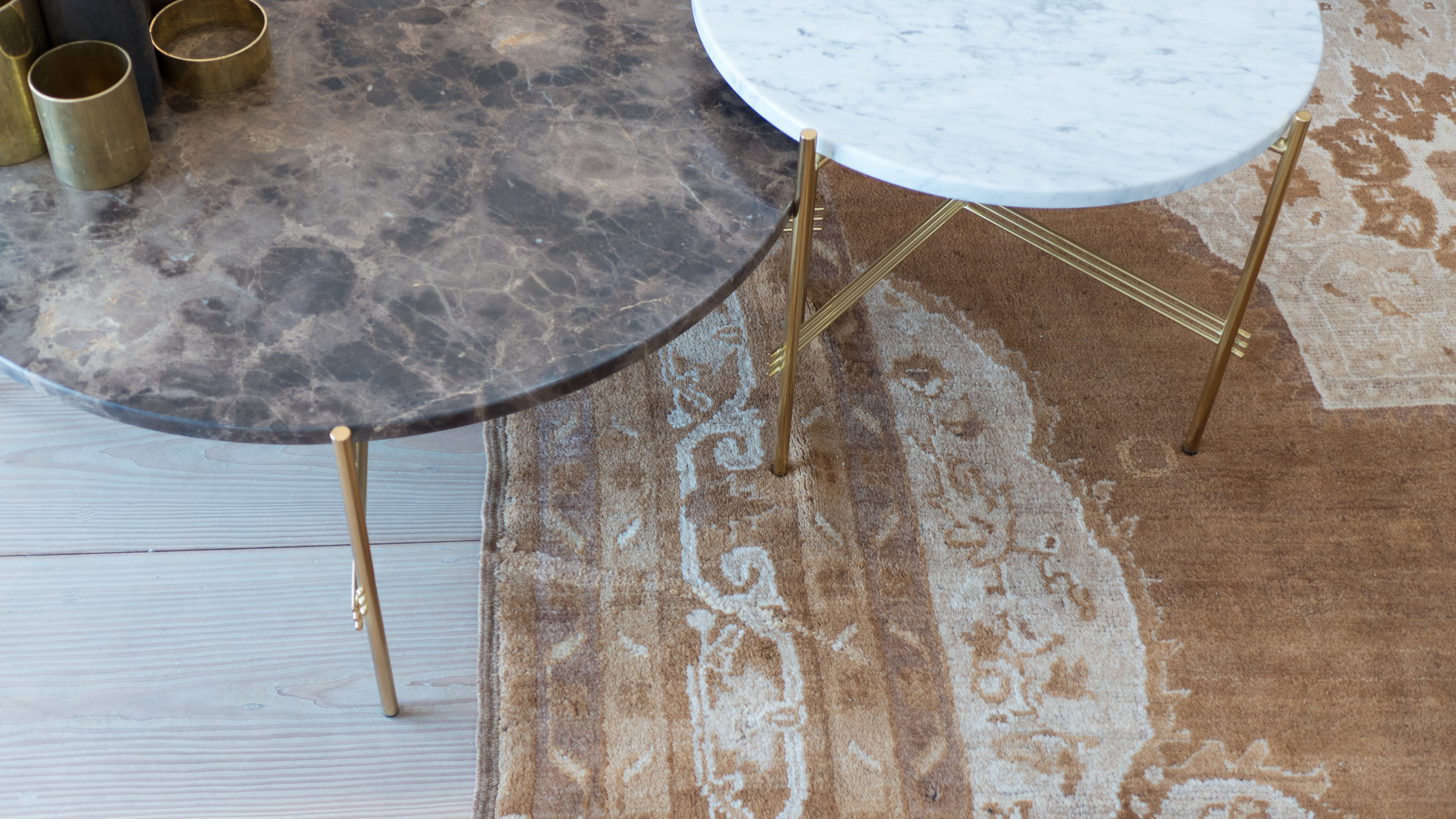

Of the three companies, Gubi has been established the longest - founded in 1967 by Gubi and Lisbeth Olsen. And of the three it is probably the least obviously Scandinavian in style. Softer and rounded, less solid shapes for chairs and sofas and the use of richer and stronger colours and the use of pattern might suggest, on first glance, that the designs are French or Italian. In fact some of the designers used by the company are French or Italian, including Jacques Adnet, Paul Leroy, Mathieu Matégot and GamFratesi - although the partnership of Stine Gam and Enrico Fratesi are actually based in Cologne. However, Gubi do also produce works from many Scandinavian designers including the Swedish designer Greta Grossman, designs from Jens Quistgaard, the Y tables by Henning Larsen and the Semi Collection of lighting from Claus Bonderup and Tursten Thorup.
A GUBI store was opened in Godthåbsvej in Frederiksberg in the early 1990s and a large new store was opened at Møntergade 19 in the centre of Copenhagen in December 2014. The main showroom, head office and studio are at Pakhus in Nordhavn in Copenhagen.
Lighting is a very important part of the Gubi Collection. From 1988 Gubi became a distributor for the Bestlite, first produced in England in the 1930s, and they now hold the licence to produce that lighting world-wide and are adding new designs to the range. They also produce the distinct Gräshoppa and Cobra lights by Greta Grossman.
Gubi have their own design of shell chair - The Gubi Collection - designed by Komplot Design in 2003. The shell appears to be flatter and wider than comparable designs, so somewhat shallower, but probably has the most complex 3D shape. Like the chairs from other companies the shell can be combined with a number of different base units including thin, splayed metal legs with, unusually, diagonally crossed stretchers; a so-called sledge frame; a swivel base and a wood base with curved and tapering legs that look almost like an inverted hand, elegant finger tips pointing down.
Metal as a surface rather than as simply a construction material has a more prominent role than with other Scandinavian design companies where wood predominates and metal is used for tables, trolleys and shelving including the Matégot Trolley and the Dedal and Demon book shelves also by Mathieau Matégot and his Kangorou tables with their pierced metal tops.
The eclectic collection, with works by current and classic designers, and with the less-common sense of central and southern European taste is acknowledged in the catalogues of Gubi that have the tag line “icons, memories and stories”.
Muuto


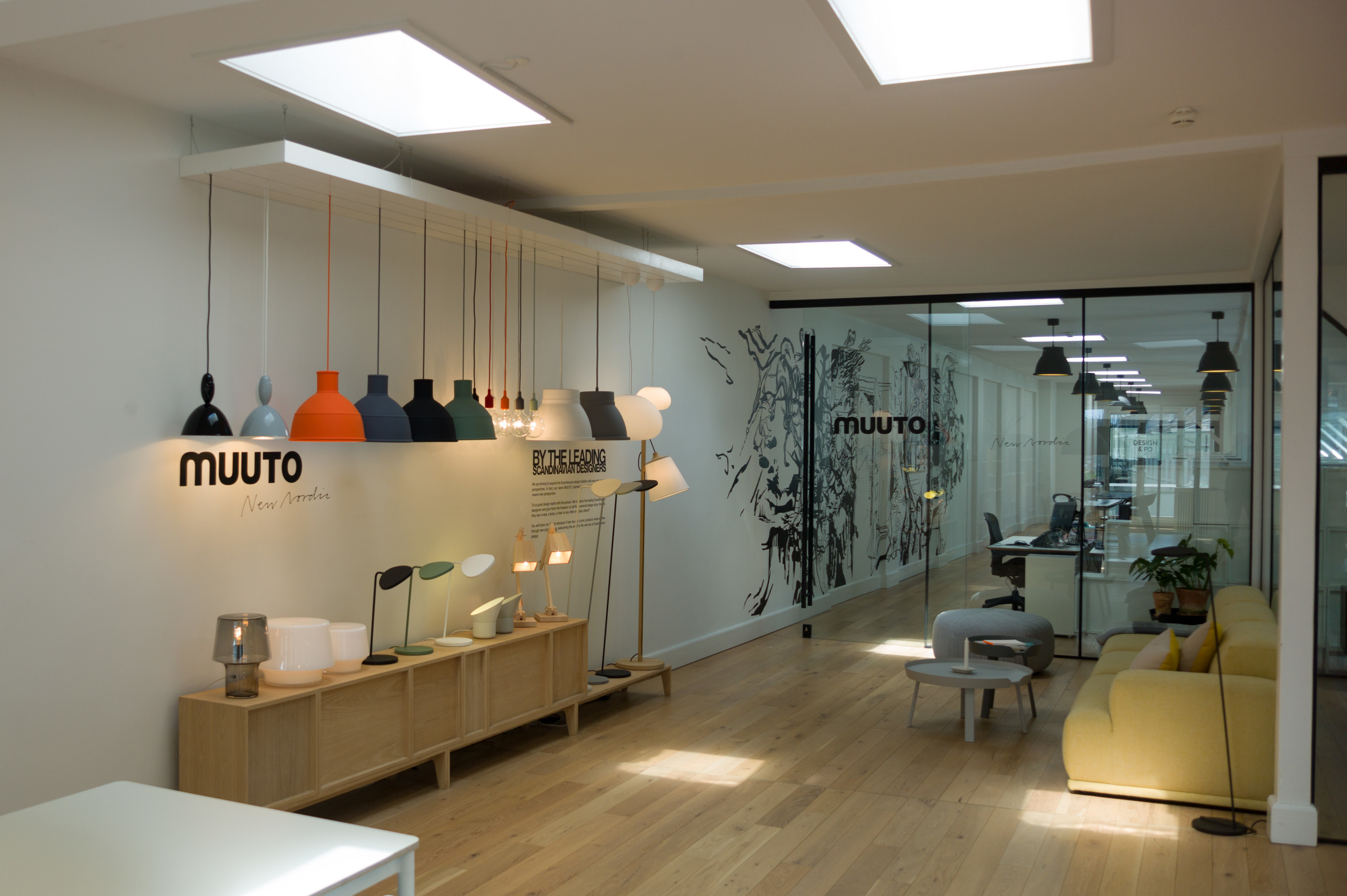
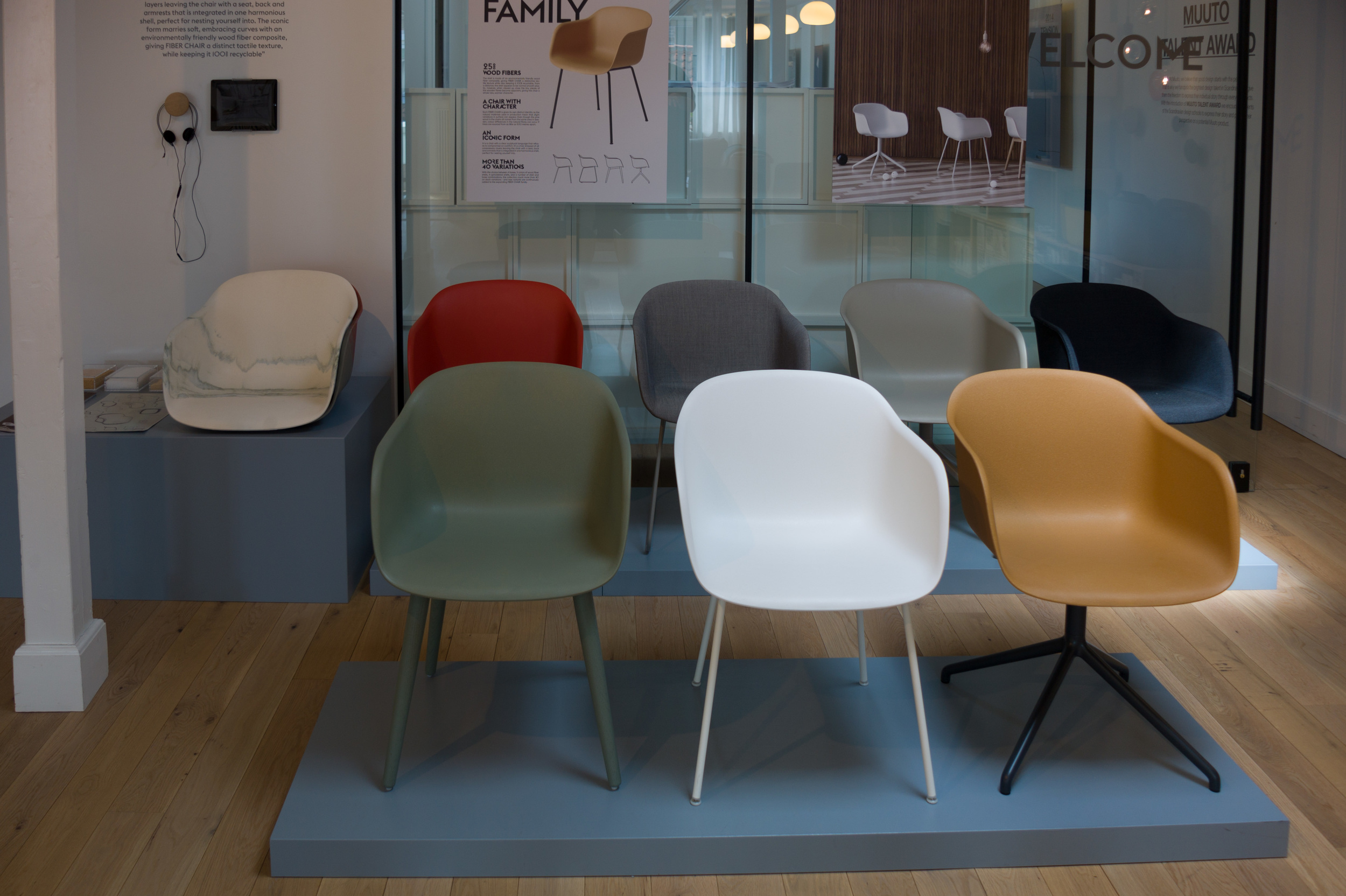
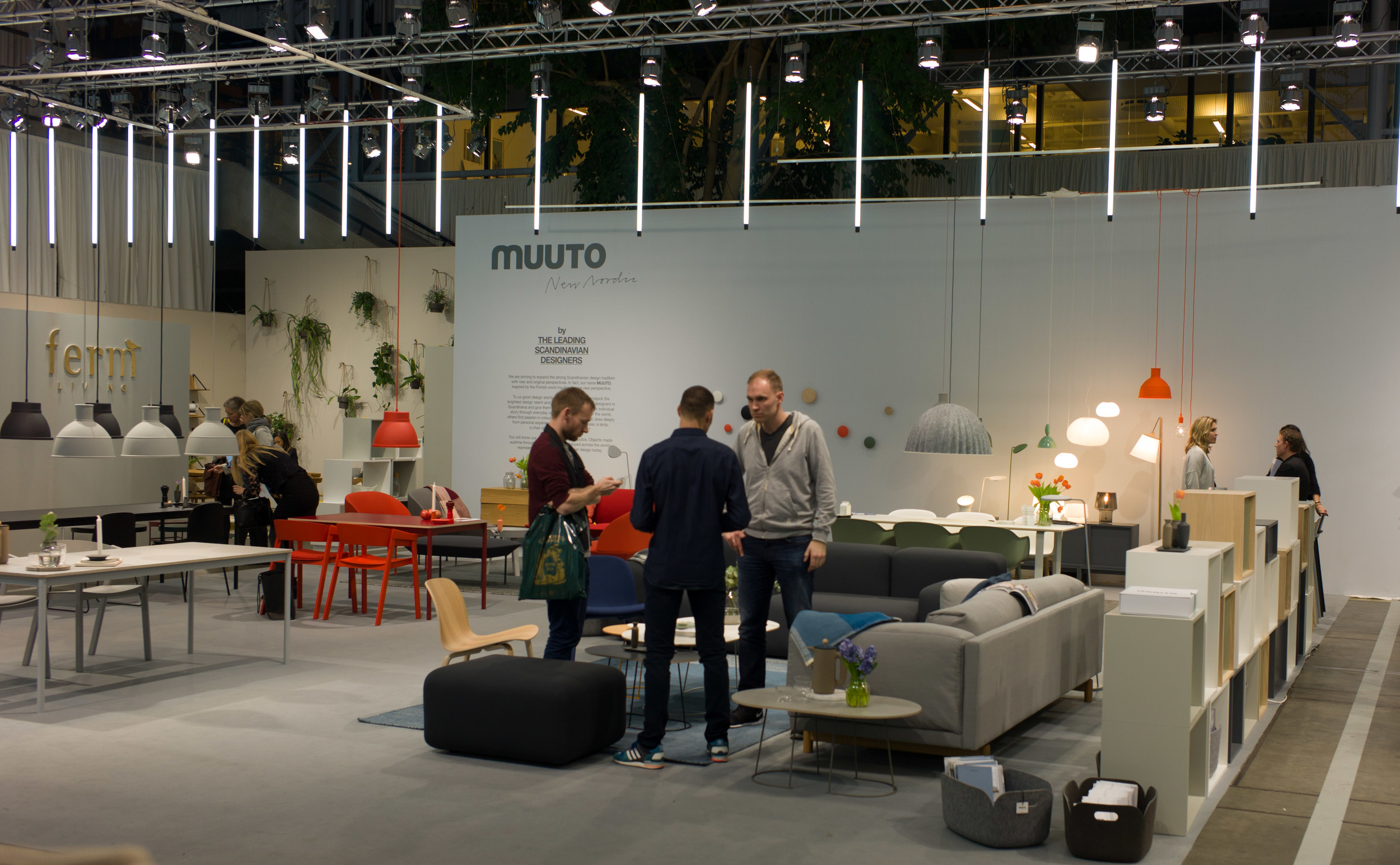
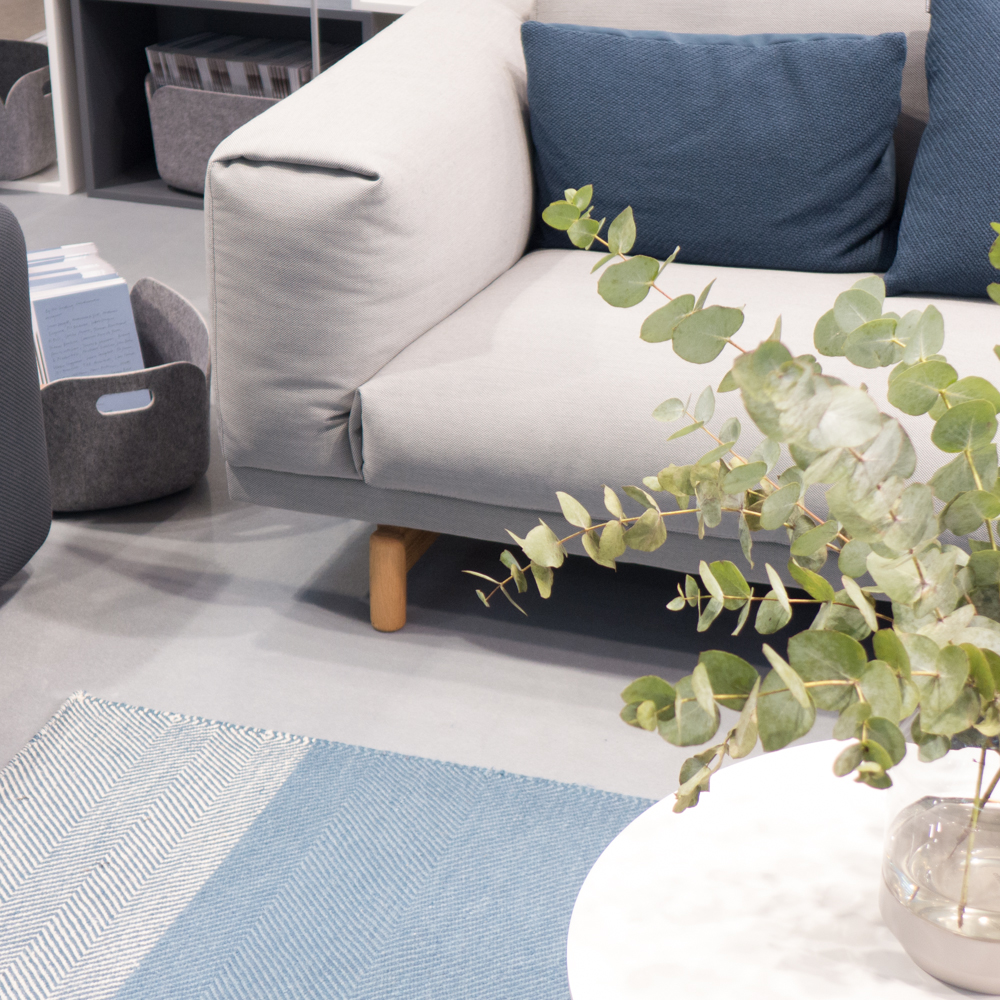
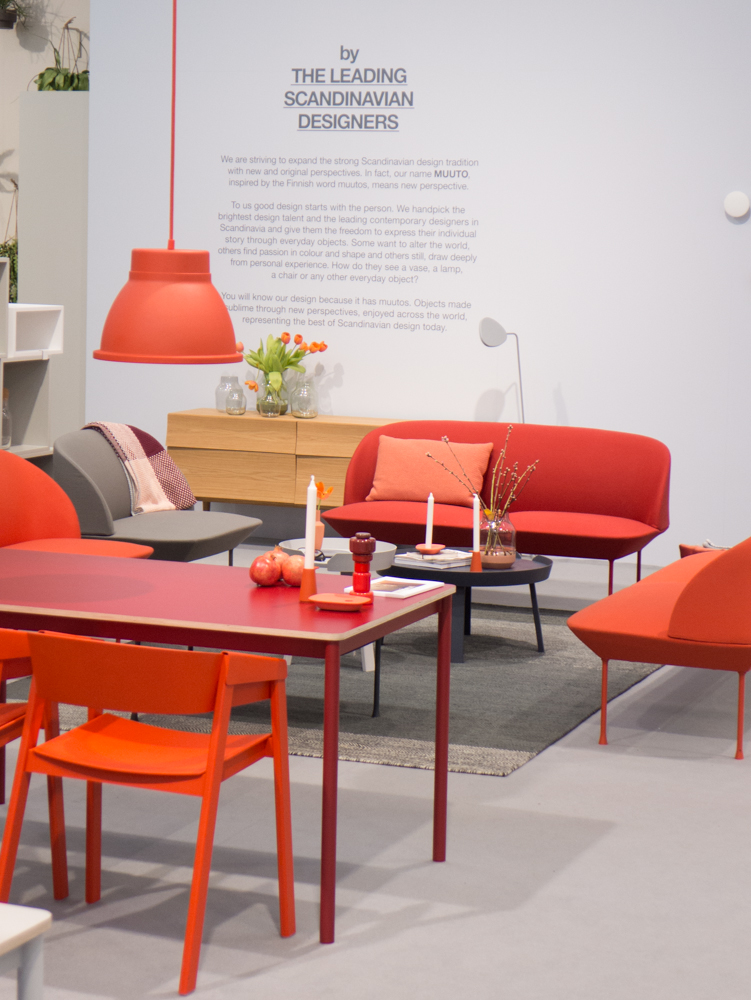

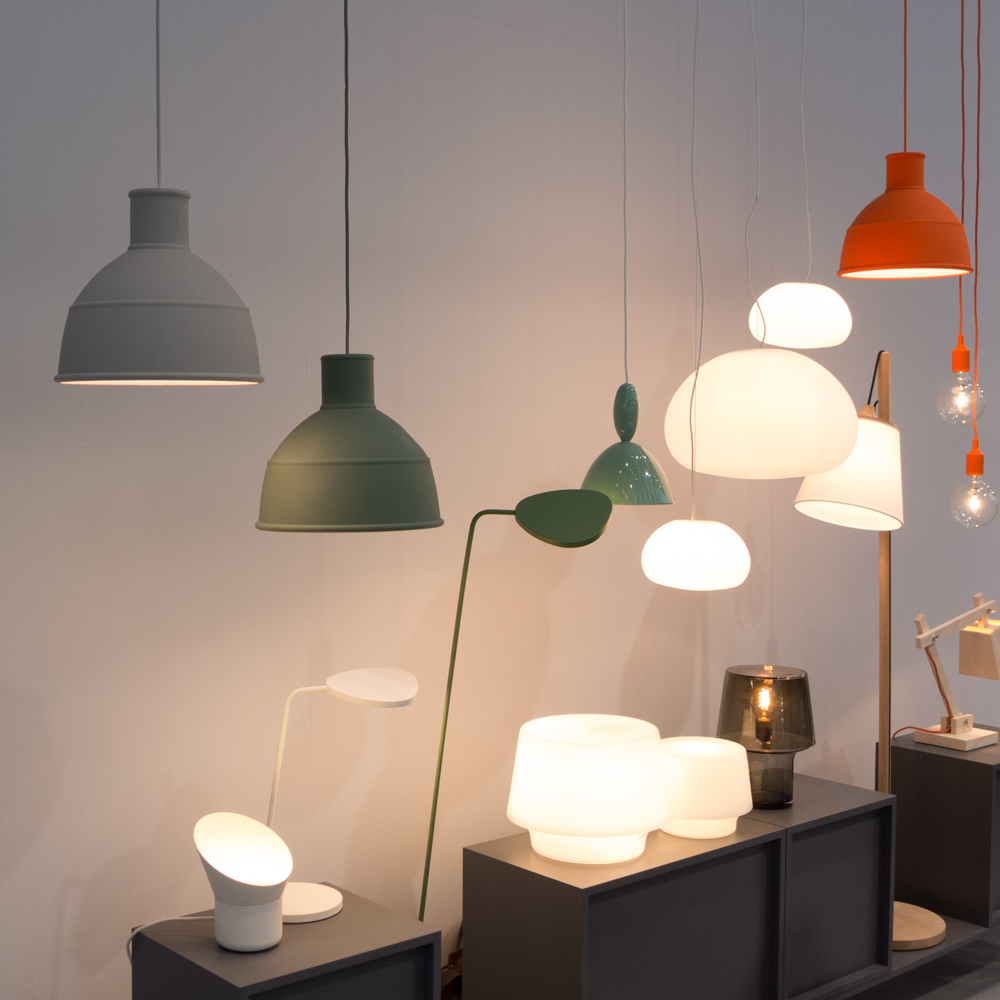
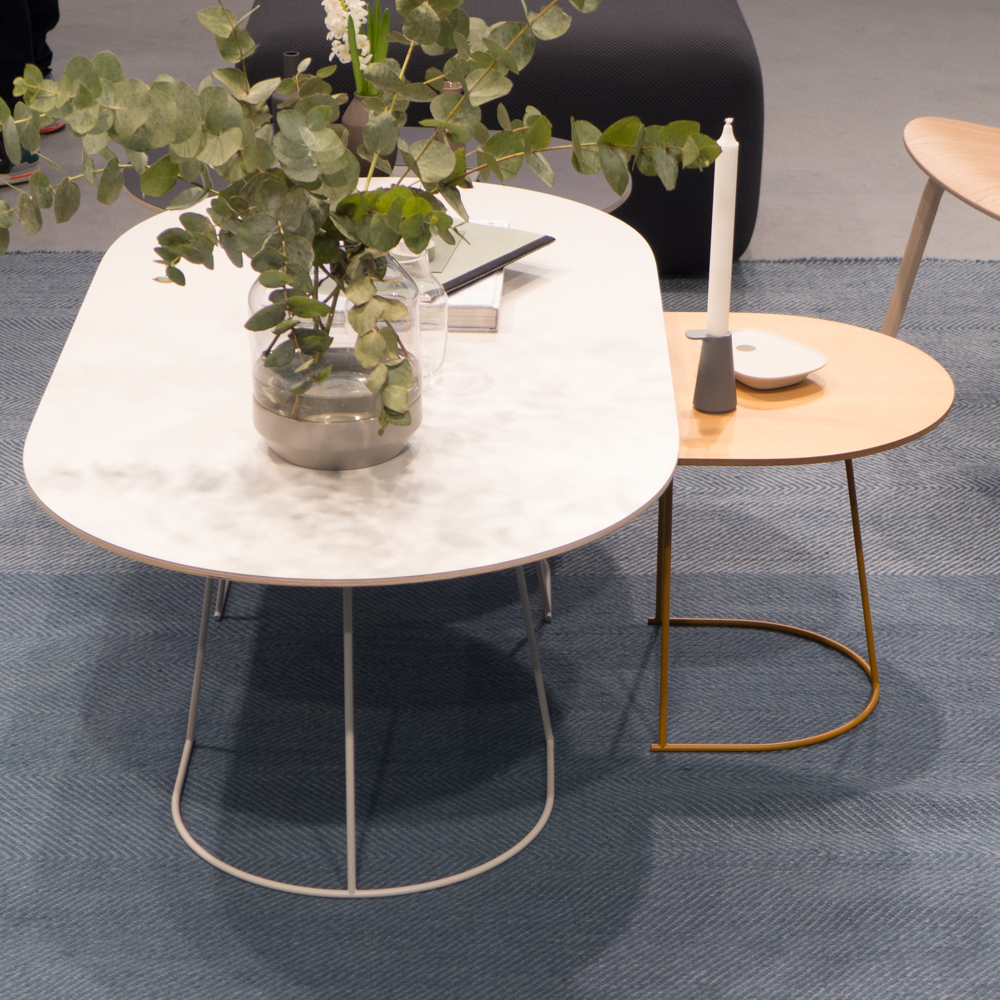
In contrast, Muuto was started about 2006 by Peter Bonnén and Kristian Byrge with the clearly-stated aim to ‘cultivate’ new Nordic design talent. The name of the company comes from the word muutos … Finnish for new perspective.
The large design studio and main showroom is in light and open attic spaces above the walking street in Copenhagen. It has a very good feeling - welcoming and open - light and friendly - with an open plan running round through offices to an entertainment space where food can be provided for staff and commercial clients and extends up on to a large open roof terrace looking across the roof tops of the city. Unlike Hay or Normann, Danish design companies of comparable size, Muuto does not have it’s own store but sells through distributors.
One key to the style of the company can be seen in the upholstered sofas and low chairs they produce that are rounded, full, covered with bold strong plain colours. Neither the Connect Sofa by Anderssen and Voll nor the Soft Block range designed by Petter Skogstad have either exposed frames or legs or feet and are deliberately sculptural - be it soft sculpture. Even the Rest Sofa - also by Anderssen and Voll - which has a low oak sub frame - has generous rounded cushions and solid well-stuffed upholstered arms. The interesting detail with the fabric covering of this range is the folded under or tucked in covers that give the sofas the suggestion of being formed with bedding. And no, that is not a snide criticism.
The Oslo Series, also by Anderssen and Voll, is slightly different with thin metal legs supporting what look almost like old-fashioned car seats that gives the range a 1950s or 60s feel.
As with Gubi, shell chairs for dining and for use as desk or side chairs are an important section of the current catalogue. The two main ranges are the Visu Chair by Mika Tolvanen in formpressed veneer giving a simple profile with generous rounded corners and the new deeper and enclosing shell shape of the Fiber Chair by Iskos-Berlin with a high wood fibre content that gives the shell a softer slightly textured look and a softer feel. As with the Gubi chairs, and as of course with the new Normann range, the chairs come with a number of options for the bases. The colours are muted and fairly dark with a grey toned red, a grey toned green and so on. These are again close to what must be considered to be the current fashionable colours because they are similar to the colour options for Normann, &Tradition and Gubi. Of all the chairs currently offered by all the Danish companies, only the new colour range for the Series 7 Chair from Fritz Hansen stands out as distinctly different with the colours selected by the artist Tal R being sharper and darker but somehow cleaner.
Muuto has a number of tables in their collection. The Adaptable Table by TAF combines wood with plastic joining knuckles, rather like the new Form range from Normann. The 70/70 Table, also by TAF, has an elegant frame in cast aluminium that forms a floor-level runner linking the legs across the short end to give the table stability without having to add cross rails or long supports down the length. The Split Table designed by Staffan Holm is even more distinct with oak legs forming what appears to be an inverted V shape angled outwards at each end but actually also splits out to support the table so, if this makes sense, like an inverted Y with the stem split and flattened out under the table top.
The Stacked range of boxes designed by Julien de Smedt can be combined to form very flexible and easily extended wall and free-standing storage. Made from MDF and with veneer or coloured finish this is a good alternative to the Montana range or the classic wood system of bookcases and shelving from Rud. Rasmussen.
As with Gubi, lighting is important, with a wide range of slightly quirky or at least different lamps from the large, industrial-looking, Unfold Pendant, which is actually in soft silicon rubber, and the Wood Lamp by TAF that looks like something produced with a child’s construction set to the minimalist and sophisticated shape of the UP Table Lamp by Mattias Ståhlbom or the blown-glass Cosy Lamps by the Finnish designer Harri Koskinen.
Muuto, more than Gubi or &Tradition have a wide range of accessories and tablewares including the relatively new Push coffee pot by Mette Duedahl, glassware, wood kitchenware and the Restore range of felt containers by Mika Tolvanen. In the extent of it’s range Muuto is probably the closest of the three to what is now often called a life-style store. I hate the phrase but, with no new alternative term, it is certainly not used disparagingly here. Far from it. Looking at the clean, bright interior of the showroom it is obvious that if furnishing from scratch a new home owner could do much worse than doing a one-stop, buy-all purchase from Muuto.
&Tradition
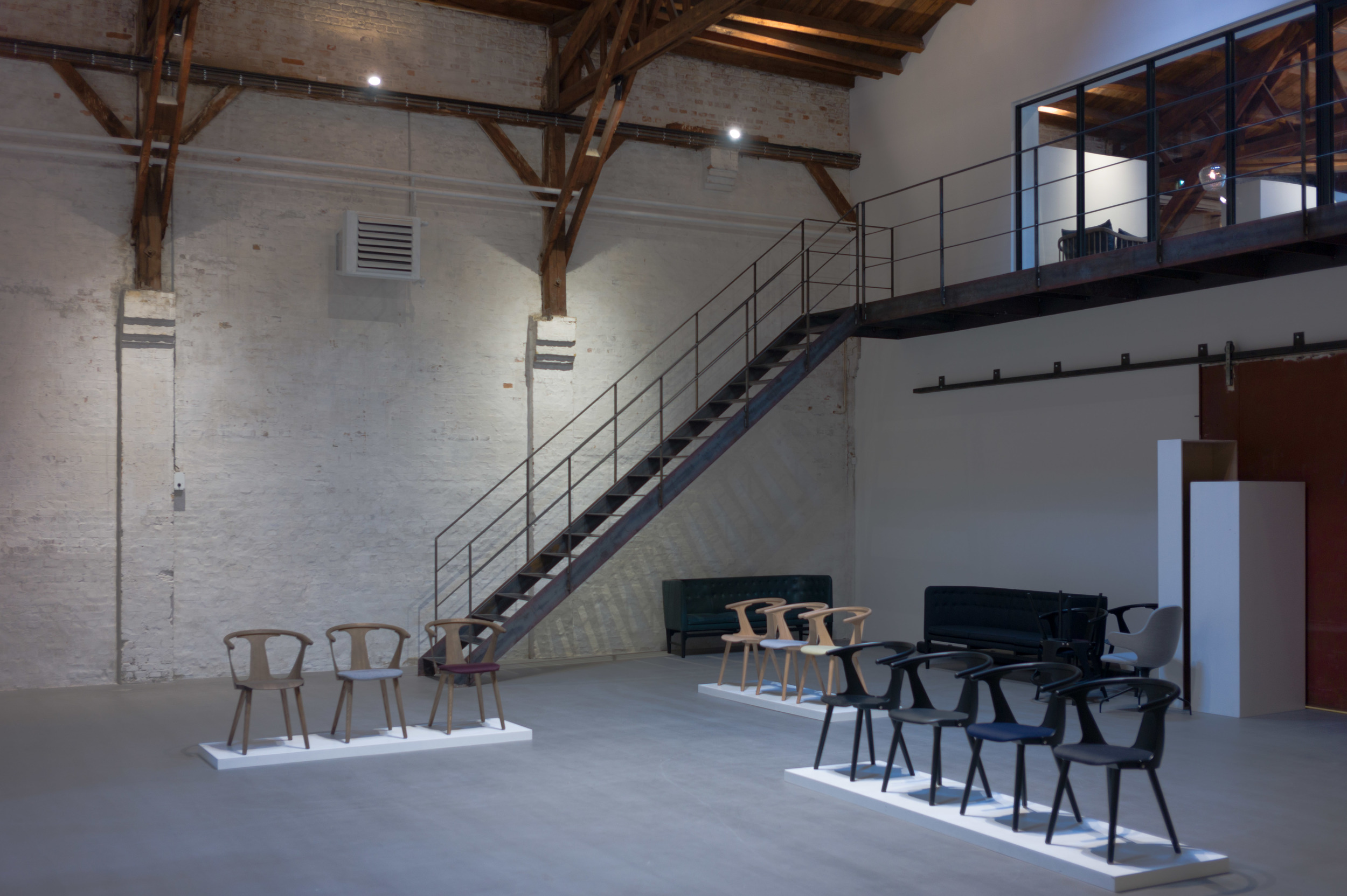
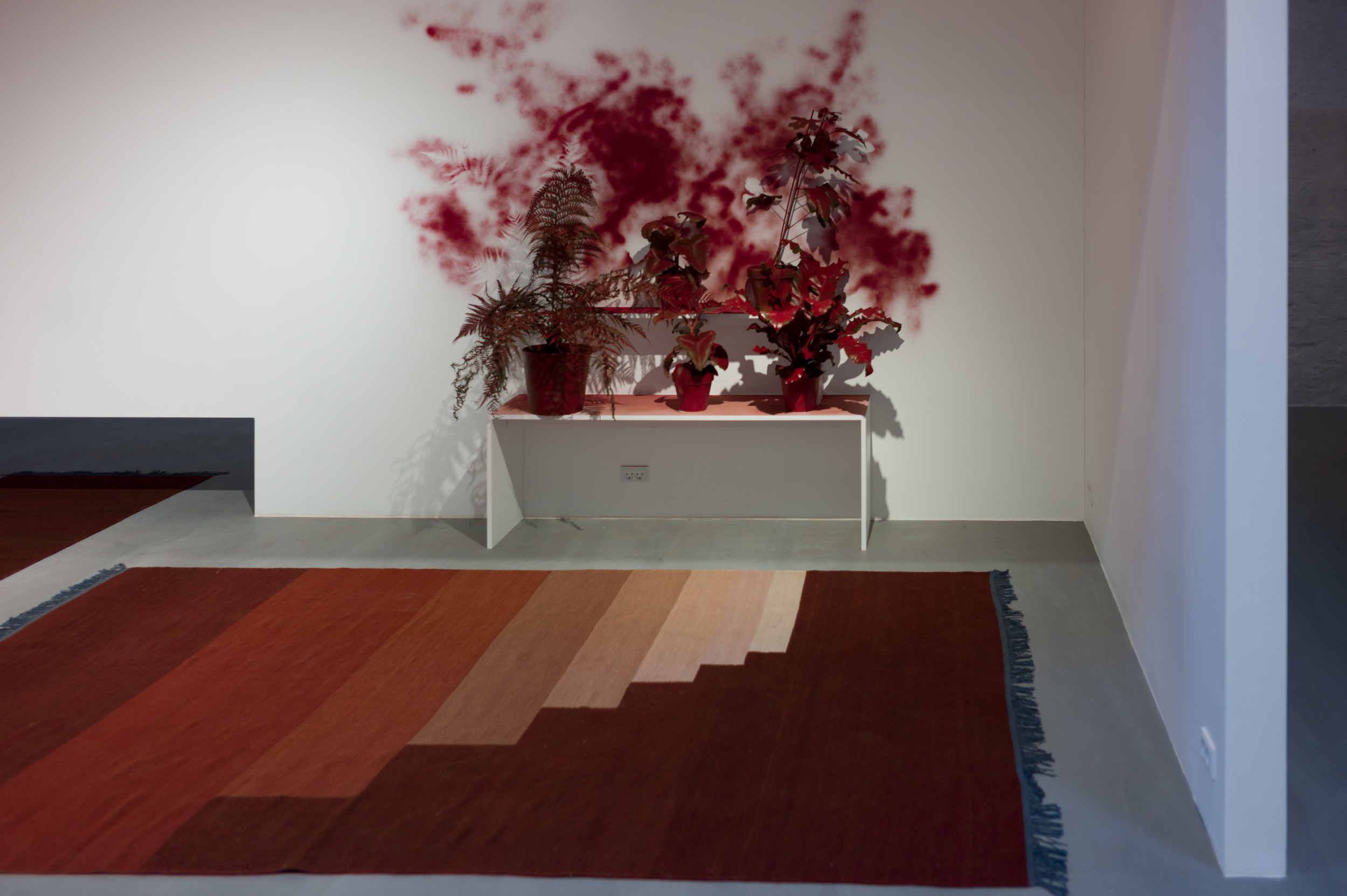
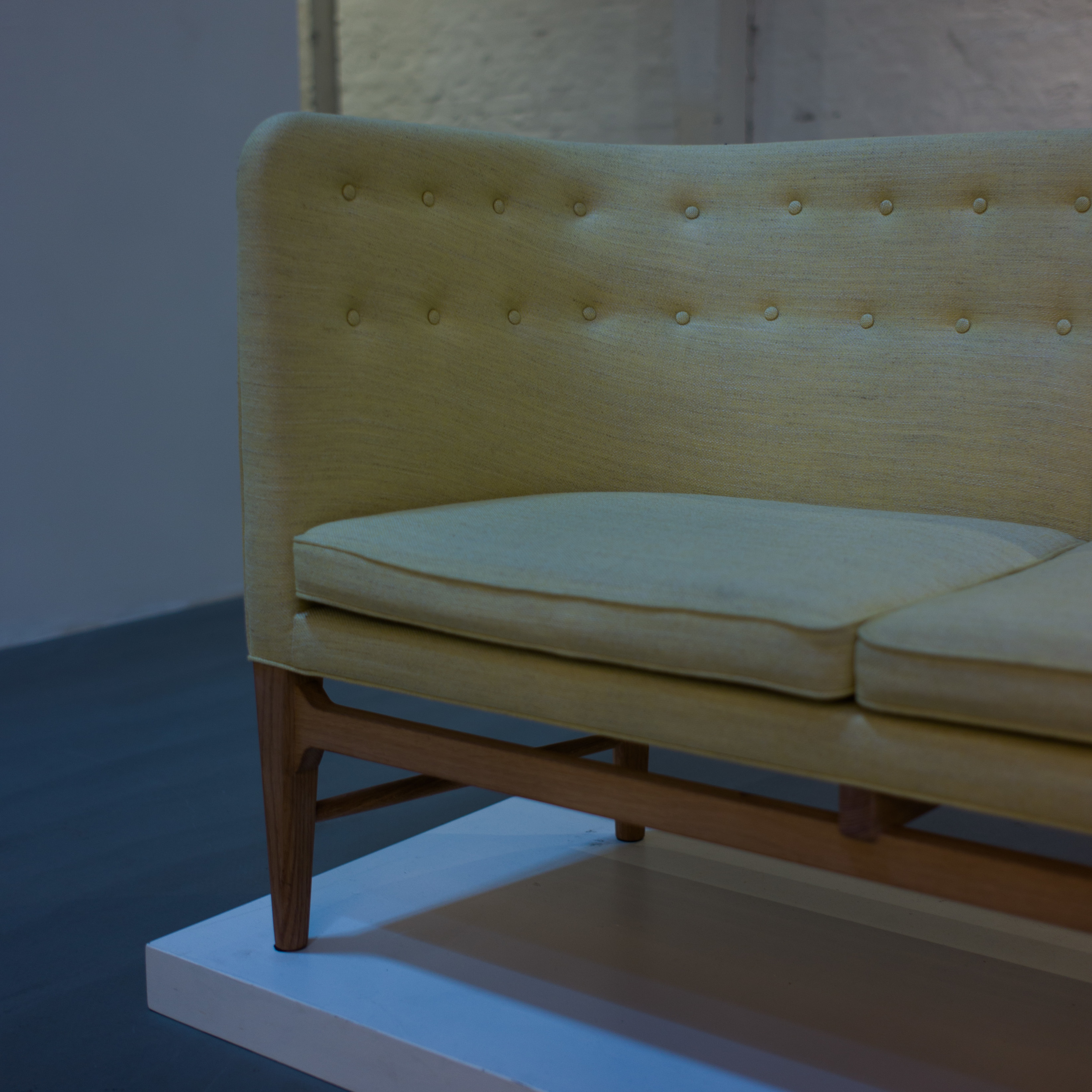

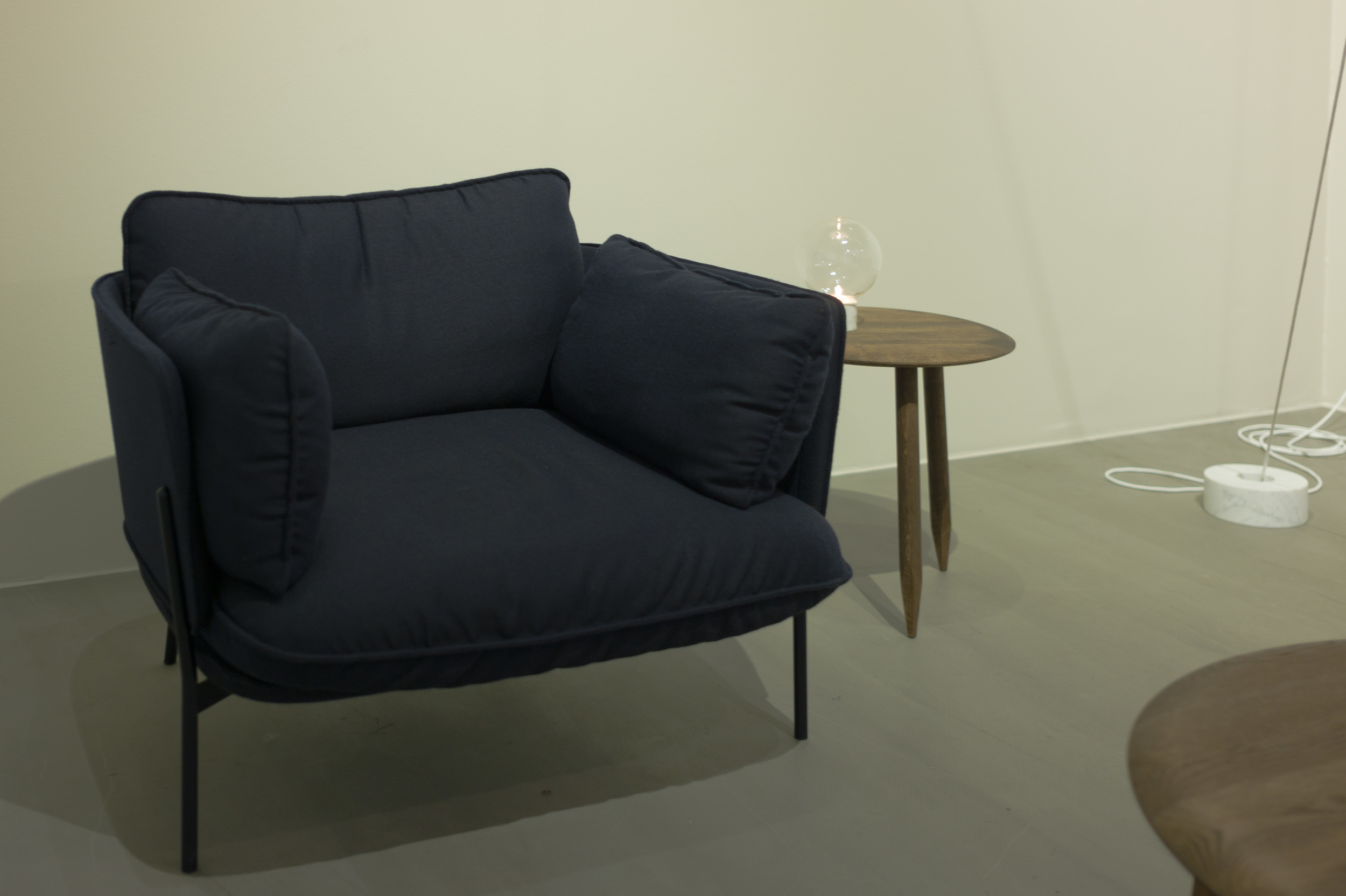
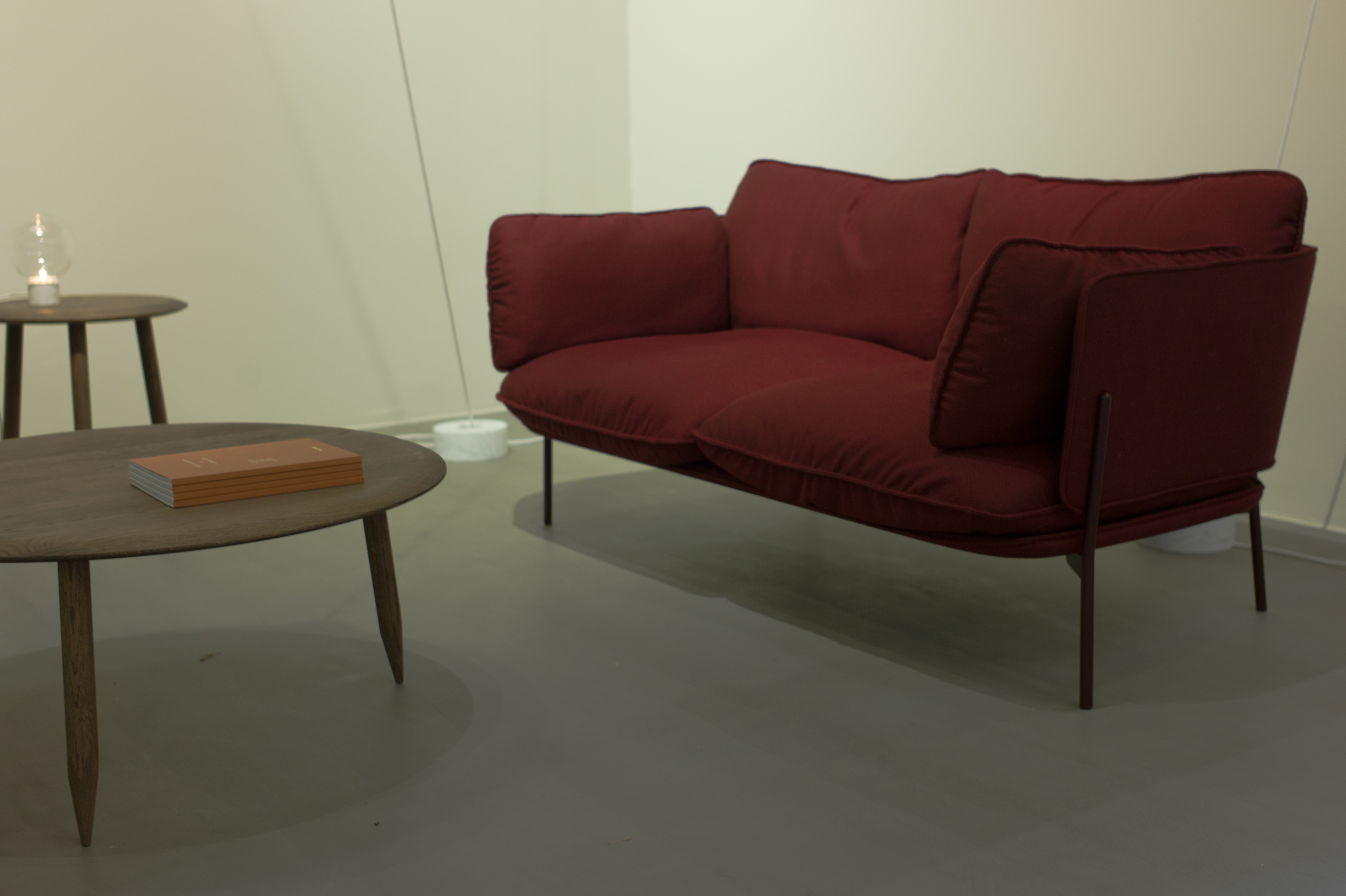

&Tradition was founded in 2010 and is very different again from Gubi and Muuto. To some extent the company has grown out of the design brand Menu and, like Menu, they have employed the Danish design and architecture partnership Norm to design products but the architects have also been responsible for the interior of the new showroom on Paper Island on the south side of the main harbour in Copenhagen. The huge, high industrial warehouse space has been divided up with simple, bold white walls to form what is described as a village … a series of simple and flexible but interlinked spaces that can be used for different displays and room settings.
As with Gubi, the collection includes a number of classic mid 20th-century designs, including pieces by Verner Panton, Arne Jacobsen and Flemming Lassen, and a growing range of newly-commissioned designs. Unlike Muuto but as with Gubi. &Tradition have looked beyond Scandinavia with designs by Lex Pott from Eindhoven, the Italian designer Luca Nichetto and Jaime Hayon with his studio in Barcelona.
The catch phrase here is “Craft meets Art. Function meets Form. Material Meets Potential” and of the three companies discussed here this is possibly the most cerebral … if Gubi is experimenting and pushing the boundaries of style and Muuto are exploring and playing with the possibilities of Scandinavian design then &Tradition are trying to be experiment more with shape and with the dramatic combination of dark and shadow. They are probably furthest from having a distinct identifiable style but that might simply be that they are the youngest company of the three.
The Fly Sofa by Space has spindles forming the back of the seat that makes this the Danish equivalent of contemporary designs from Sweden from GAD or Norrgavel; the Catch Chair from 2014 by Jaime Hayon with its enclosing arms plays with silhouette and weight … a distinct profile balanced on thin spidery legs … and the chairs In Between by Sami Kallio have cut-out and bent shapes for the seat back that, again, play with silhouette and shadow and profile. It is not surprising that the chairs and tables from the range in the increasingly fashionable dark stains are the best selling.
Cloud, upholstered seating with a choice of one, two or three seats, by Luca Nichetto is again a clever and again a successful and distinctive design with metal legs but a sophisticated and elegant design with the legs set out at a slight angle and with the back legs continuing just half way up the back … almost like giving a gentle helping hand to support the wrap around and upholstered panel … there is a short thin fin running inwards under the seat from the legs that again give just an impression of support but no clues to the underlying structure. The cushions, without boxed sides or pimore like over-filled pillows, are again distinctly different to current Scandinavian upholstery that is either sharply tailored and buttoned and piped or is rounded but solidly and almost over filled.
Table NA2 and Stool NA3 from Norm are again clever and ostensibly stripped down to a minimal form but are very very sophisticated and clever in the details of their construction. The tables actually have three legs at each end … the corner legs angled outwards and a leg in the centre of the end angled in to form a trestle … and the stools with a rounded broom-stick like leg that is again angled for stability but is not housed directly into the seat but has a narrow stem … making it like an inverted bullrush … and the cross rails are actually a T-bar so curiously the circular stools have a front - with space for both feet raised off the ground - and that puts the single leg at the centre under the back pushing the sitter to use the stool in the most stable orientation. As I say … clever playing with what initially seems to be a stripped down minimal design.
There is a surprisingly broad range of lighting design from the simple exposed bulb and marble block of Marble Light by Studio Vit; a slightly salvaged-from-a-factory look of Light Forest from Ontwerpduo and the elegant metal shade and elegant metal grab and knurled fixing bolts of the Copenhagen Pendant from 2014 by Space of Copenhagen. &Tradition are also producing the Flowerpot lights by Verner Panton from 1968 in new colours and their equivalent of the wood lamp from Muuto is a table lamp by Victor Vetterlein in paper pulp called Trash Me that looks like a lamp from the Pixar movie that has lost a fight with a porridge/paint mix.
So!
Well all three companies focus on the major furniture items - chairs, tables and sofas - along with a broad range of lighting and some additional furniture such as trolleys and shelving. As to style … well, as always, it is invidious to talk about style without sounding as if you are either condemning or praising. Perhaps the opt out is to say that after visiting the three show rooms over just a couple of days, I can see that Gubi are focusing on a slightly less conventional style for Scandinavia along with carefully controlled quality aiming at the upper end of the market. Muuto are pushing and playing with more conventional Scandinavian style to produce something light and open and friendly … perhaps a style that is aimed more at young couples or young families. &Tradition look as if they are moving towards drama and pieces that will stimulate comments. If you put a chair from each company side by side then you would be hard pressed to separate them in terms of quality or style or functionality. You would have to go into a careful description of technical details to distinguish them. On the other hand, be dropped from space into any of the three showrooms and it would be impossible to mix them up.
* I am very grateful to the staff at all three companies, to Michael, Jesper and Elizabeth, who gave me so much of their time to answer questions and to discuss wider design issues as well as allowing me to take photographs.































